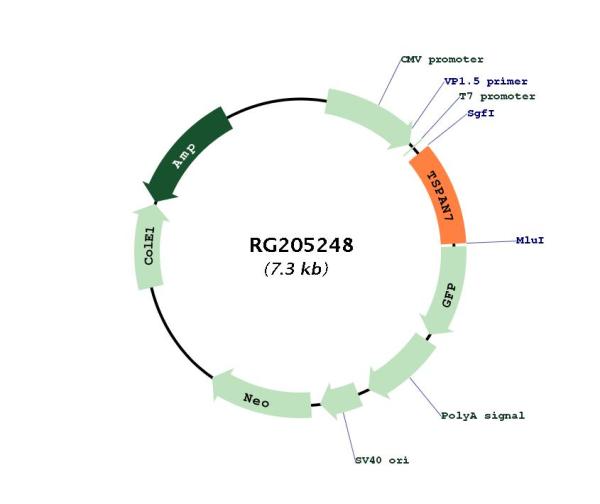TM4SF2 (TSPAN7) (NM_004615) Human Tagged ORF Clone
CAT#: RG205248
- TrueORF®
TSPAN7 (tGFP-tagged) - Human tetraspanin 7 (TSPAN7)
ORF Plasmid: DDK
Lentiviral Particles: DDK DDK w/ Puro mGFP mGFP w/ Puro
AAV Particle: DDK
"NM_004615" in other vectors (6)
Specifications
| Product Data | |
| Type | Human Tagged ORF Clone |
| Tag | TurboGFP |
| Symbol | TM4SF2 |
| Synonyms | A15; CCG-B7; CD231; DXS1692E; MRX58; MXS1; TALLA-1; TM4SF2; TM4SF2b |
| Vector | pCMV6-AC-GFP |
| E. coli Selection | Ampicillin (100 ug/mL) |
| Mammalian Cell Selection | Neomycin |
| Sequence Data |
>RG205248 representing NM_004615
Red=Cloning site Blue=ORF Green=Tags(s) TTTTGTAATACGACTCACTATAGGGCGGCCGGGAATTCGTCGACTGGATCCGGTACCGAGGAGATCTGCC GCCGCGATCGCC ATGGCATCGAGGAGAATGGAGACCAAACCTGTGATAACCTGTCTCAAAACCCTCCTCATCATCTACTCCT TCGTCTTCTGGATCACTGGGGTGATCCTGCTGGCTGTTGGAGTCTGGGGCAAACTTACTCTGGGCACCTA TATCTCCCTTATTGCCAAGAACTCCACAAATGCTCCCTATGTGCTCATCGGAACTGGCACCACTATTGTT GTCTTTGGCCTGTTTGGATGCTTTGCTACATGTCGTGGTAGCCCATGGATGCTGAAACTGTATGCCATGT TTCTGTCCCTGGTGTTCCTGGCTGAGCTCGTAGCTGGCATTTCAGGGTTTGTGTTTCGTCATGAGATCAA GGACACCTTCCTGAGGACTTACACGGACACTATGCAGACTTACAATGGCAATGATGAGAGGAGCCGGGCA GTGGACCATGTGCAGCGCAGCCTGAGCTGCTGTGGTGTGCAGAACTACACCAACTGGAGCACCAGCCCCT ACTTCCTGGAGCATGGCATCCCCCCCAGCTGCTGCATGAACGAAACTGATTGTAATCCCCAGGATCTACA CAATCTGACTGTGGCCGCCACCAAAGTTAACCAGAAGGGTTGTTATGATCTGGTAACTAGTTTCATGGAG ACTAACATGGGAATCATCGCTGGAGTGGCGTTTGGAATCGCATTCTCCCAGTTAATTGGCATGCTGCTGG CCTGCTGTCTGTCCCGGTTCATCACGGCCAATCAGTATGAGATGGTG ACGCGTACGCGGCCGCTCGAG - GFP Tag - GTTTAA >RG205248 representing NM_004615
Red=Cloning site Green=Tags(s) MASRRMETKPVITCLKTLLIIYSFVFWITGVILLAVGVWGKLTLGTYISLIAKNSTNAPYVLIGTGTTIV VFGLFGCFATCRGSPWMLKLYAMFLSLVFLAELVAGISGFVFRHEIKDTFLRTYTDTMQTYNGNDERSRA VDHVQRSLSCCGVQNYTNWSTSPYFLEHGIPPSCCMNETDCNPQDLHNLTVAATKVNQKGCYDLVTSFME TNMGIIAGVAFGIAFSQLIGMLLACCLSRFITANQYEMV TRTRPLE - GFP Tag - V |
| Restriction Sites |
SgfI-MluI
Cloning Scheme for this gene
Plasmid Map

|
| ACCN | NM_004615 |
| ORF Size | 747 bp |
| OTI Disclaimer | The molecular sequence of this clone aligns with the gene accession number as a point of reference only. However, individual transcript sequences of the same gene can differ through naturally occurring variations (e.g. polymorphisms), each with its own valid existence. This clone is substantially in agreement with the reference, but a complete review of all prevailing variants is recommended prior to use. More info |
| OTI Annotation | This clone was engineered to express the complete ORF with an expression tag. Expression varies depending on the nature of the gene. |
| Product Components | The ORF clone is ion-exchange column purified and shipped in a 2D barcoded Matrix tube containing 10ug of transfection-ready, dried plasmid DNA (reconstitute with 100 ul of water). |
| Reconstitution | 1. Centrifuge at 5,000xg for 5min. 2. Carefully open the tube and add 100ul of sterile water to dissolve the DNA. 3. Close the tube and incubate for 10 minutes at room temperature. 4. Briefly vortex the tube and then do a quick spin (less than 5000xg) to concentrate the liquid at the bottom. 5. Store the suspended plasmid at -20°C. The DNA is stable for at least one year from date of shipping when stored at -20°C. |
| Reference Data | |
| RefSeq | NM_004615.2, NP_004606.2 |
| RefSeq Size | 1813 bp |
| RefSeq ORF | 750 bp |
| Locus ID | 7102 |
| UniProt ID | P41732 |
| Cytogenetics | Xp11.4 |
| Domains | transmembrane4 |
| Protein Families | Druggable Genome, Transmembrane |
| Gene Summary | The protein encoded by this gene is a member of the transmembrane 4 superfamily, also known as the tetraspanin family. Most of these members are cell-surface proteins that are characterized by the presence of four hydrophobic domains. The proteins mediate signal transduction events that play a role in the regulation of cell development, activation, growth and motility. This encoded protein is a cell surface glycoprotein and may have a role in the control of neurite outgrowth. It is known to complex with integrins. This gene is associated with X-linked cognitive disability and neuropsychiatric diseases such as Huntington's chorea, fragile X syndrome and myotonic dystrophy. [provided by RefSeq, Jul 2008] |
Documents
| Product Manuals |
| FAQs |
| SDS |
Resources
Other Versions
| SKU | Description | Size | Price |
|---|---|---|---|
| RC205248 | TSPAN7 (Myc-DDK-tagged)-Human tetraspanin 7 (TSPAN7) |
USD 300.00 |
|
| RC205248L1 | Lenti ORF clone of Human tetraspanin 7 (TSPAN7), Myc-DDK-tagged |
USD 600.00 |
|
| RC205248L2 | Lenti ORF clone of Human tetraspanin 7 (TSPAN7), mGFP tagged |
USD 600.00 |
|
| RC205248L3 | Lenti ORF clone of Human tetraspanin 7 (TSPAN7), Myc-DDK-tagged |
USD 600.00 |
|
| RC205248L4 | Lenti ORF clone of Human tetraspanin 7 (TSPAN7), mGFP tagged |
USD 600.00 |
|
| SC126663 | TSPAN7 (untagged)-Human tetraspanin 7 (TSPAN7) |
USD 300.00 |
{0} Product Review(s)
Be the first one to submit a review






























































































































































































































































 Germany
Germany
 Japan
Japan
 United Kingdom
United Kingdom
 China
China

